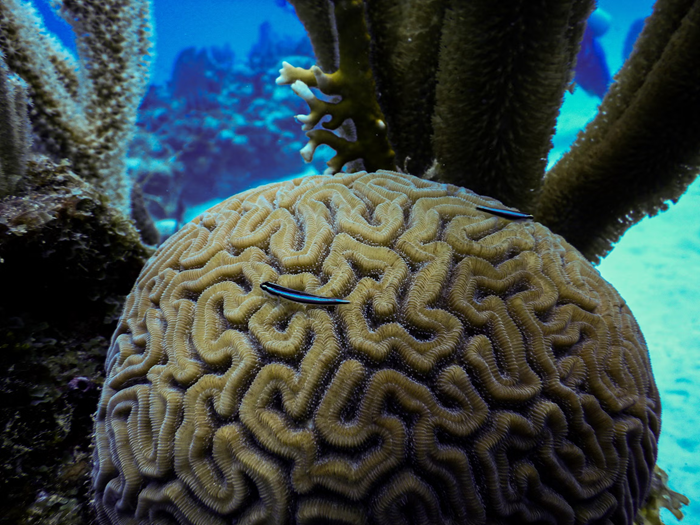Reviewed by Lexie CornerJun 6 2025
When humans need skincare, they visit clinics or spas. Fish, on the other hand, head to coral reefs’ natural “cleaning stations” - active gathering spots where they wait to be cleaned by smaller fish.
 Cleaner gobies set up “shop” in coral reefs, attracting bigger fish “clients,” who come to have their scales cleaned of parasites and bacteria. Scientists are studying the role these little fish play in reef microbial diversity. Image Credit: Matthew Nicholson, University of Miami
Cleaner gobies set up “shop” in coral reefs, attracting bigger fish “clients,” who come to have their scales cleaned of parasites and bacteria. Scientists are studying the role these little fish play in reef microbial diversity. Image Credit: Matthew Nicholson, University of Miami
These cleaner fish move around and under their much larger visitors, even entering their mouths to remove germs and parasites. The process is similar to a car wash servicing a large vehicle. Sometimes, the cleaners even brush against their clients, which may have a calming effect.
Beyond these cleaning benefits, researchers are asking a new question: What role do cleaner fish stations play in spreading microbes and bacteria, whether helpful or harmful, across the reef?
A study published in Marine Ecology Progress Series is the first to examine how cleaner fish stations affect microbial diversity on reefs. The research was led by scientists from the University of California, Davis, and the Woods Hole Oceanographic Institution (WHOI), in collaboration with the University of Miami’s Rosenstiel School of Marine, Atmospheric, and Earth Science.
Could active cleaning stations act like waiting rooms in medical clinics - places where microbes and pathogens spread more easily? Or could they help distribute beneficial microorganisms within reef communities? These questions have important implications for coral reef conservation and restoration.
How pathogens or microbes are moving around a reef could be critically important to understanding how individuals will be affected. We know microbes play a role in coral bleaching, for example. This study really lays a foundation for using cleaner fish stations as a way to study the movement of microbes around the reef environment.
Anya Brown, Study Lead Author and Assistant Professor, Department of Evolution and Ecology, University of California, Davis
Cleaner Fish and Reef Health
The cleaning goby, a small fish with a distinctive colored stripe along its body, is a consistent participant in reef cleaning stations. In June 2021, researchers removed cleaning gobies from cleaning stations on two Caribbean reefs - one in Puerto Rico and one in St. Croix - to study how cleaner fish affect microbial diversity.
They analyzed water nutrient levels and microbial communities in reef areas with and without gobies. This included monitoring resident damselfish, which commonly interact with cleaner gobies.
The researchers found that cleaner fish visited more locations on reefs where they were present compared to those where they were removed. They also observed that cleaner fish influence both damselfish behavior and reef microbial diversity. However, the extent of this impact varied by substrate type and environmental conditions, as each reef had a unique microbial profile. Differences were also noted in client fish activity, nutrient levels, and bacterial cell density in the water.
According to the authors, the results suggest another potential role of cleaner fish in reef ecosystems. They also emphasize the need for further research into how these fish contribute to shaping microbial diversity and transmission on coral reefs.
Tiny Fish Can Have a Big Impact
While larger organisms on coral reefs attract the most attention, the study underscores the huge impact tiny organisms such as these fish can have and how important they are to helping healthy reef ecosystems function. While cleaner fish are well-known for their role in consuming parasites and reducing stress in other fish, this is the first field study to quantify their effects on microbes of other fish and the surrounding coral reef environment.
Paul Sikkel, Study Co-Author and Research Professor, Rosenstiel School’s Department of Marine Biology and Ecology, University of Miami
Gobies at the cleaning station
This YouTube clip of gobies cleaning a fish at the New England Aquarium is similar to what happens in coral reefs in the wild, as cleaner fish clean larger fish clients of bacteria and parasites. (New England Aquarium) Video Credit: University of California, Davis
Source:
Journal reference:
Brown, A., et al. (2025) Context-dependent effects of a Caribbean cleaner goby on coral reef microbial communities. Marine Ecology Progress Series. doi.org/10.3354/meps14851.